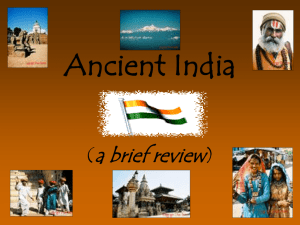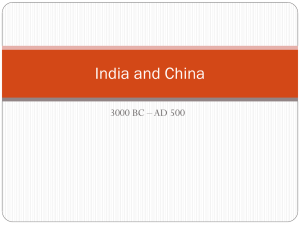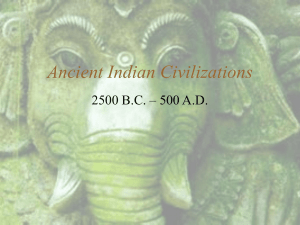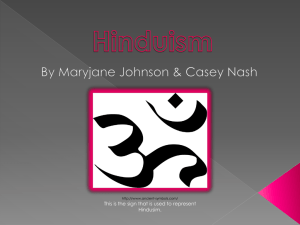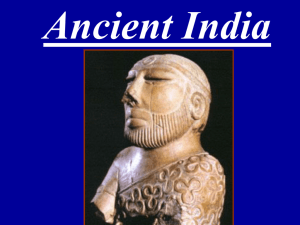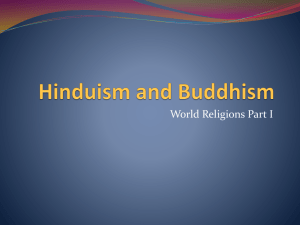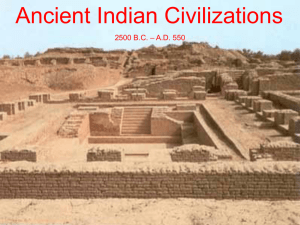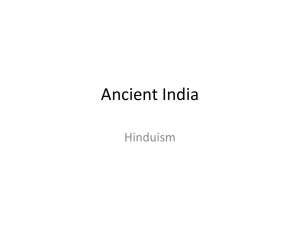File - Social Studies
advertisement
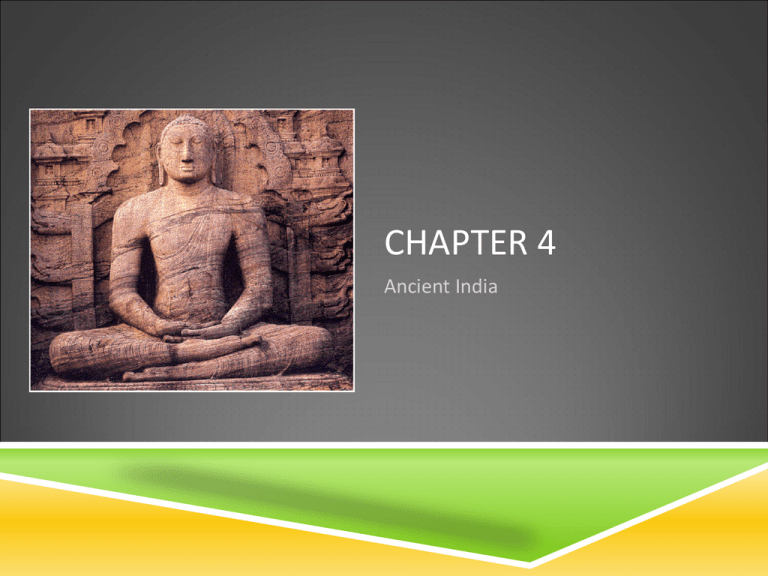
CHAPTER 4 Ancient India SECTION ONE OBJECTIVES -Learn about India’s geographic settings -Find out about life in an ancient city of the Indus River Valley -Examine the rise of a new culture in the Indus and Ganges River Valleys India’s geographic setting Subcontinent-a large landmass that juts out from a continent Stretches out from the Himalayas and juts out from Asia into the Indian Ocean Historians refer to the entire subcontinent as India, although today it is divided into several countries, including India, Pakistan, and Bangladesh. The land of India is separated India’s geographic setting from the rest of the world by a great wall. This wall stretches along India’s northern border and stretches 1,500 miles long and nearly 5 miles high. It is a wall of snow capped peaks and icy glaciers called the Himalayan mountains, the highest mountain range in the world. SATELLITE IMAGE OF INDIA The subcontinent of India A CLIMATE OF MONSOONS India’s climate is dominated by monsoons (strong winds that blow across the region at certain times of the year). A CLIMATE OF MONSOONS From October to May, the winter monsoon blows from the northeast, spreading dry air across the country. In the middle of June, the wind blows from the Indian Ocean, picking up moisture from the ocean. It carries rains that drench the plains and river valleys daily. A CLIMATE OF MONSOONS The people of India depend on summer monsoons to provide life-giving rain. If the monsoon is late or weak, crops die, causing famine. If it brings too much rain, overflowing rivers may cause deadly floods. BARRIERS AND PATHWAYS The mountains that separate India from other lands, they do have openings. These openings have served as highways for migration and invasion. The earliest people of northern India probably entered the Indus River Valley through the pathways of the Himalayas. How do winter monsoons differ from summer monsoons? Look on pg. 108 at the “Stone Seals” How do these seals compare to the ways that present-day merchant identify their goods? Life in the Indus River Valley Because of the rich soil in the Indus River Valley, there was a surplus of food, creating a population boom. Villages turned into cities, and around 25001500 B.C., two wellplanned cities flourished in the valleyMohenjo-Daro and Harappa. Mohenjo-Daro To help protect the city from floods, it was built above ground level. The city’s highest point served as a citadel-or fortress. Homes and workshops make up one side of the city while public buildings make up the other. Streets separated these regular blocks of homes and buildings. MOHENJO-DAR0 http://www.youtube.com/watch?v=SdGbamPgf8o MOHENJO-DARO The citadel was built on a high mound of earth. It probably protected the city’s most important buildings, including a storehouse for grain and a bath house. MOHENJO-DARO Advanced for its time, Outside the city, canals Mohenjo-Daro had a drainage system. Clay pipes ran under brick streets and carried waste from homes and public buildings away from the city. ran along the Indus River, which often flooded. The canals helped control flooding by catching overflow from the river. The water was then directed where it was most needed. MOHENJO-DARO DRAINAGE SYSTEM LIFE IN MOHENJO-DARO Merchants and artisans lined the streets. Traders came from as far away as Mesopotamia to buy and sell goods. Citizens of the city lived in homes that opened onto courtyards. Children played with toys and pets. Adults enjoyed games and music. Artisans fashioned jewelry and bright cotton clothing for the people to wear. MOHENJO-DARO TOYS TRADE CLAY ELEPHANTS ECONOMY These weights were found in recent excavations at Harappa and may have been used for controlling trade and possibly for collecting taxes. CLAY SCULPTURES CERAMICS ORNAMENTS NECKLACE BURIAL BURIAL Burial of woman and infant, Harappa. This burial was disturbed in antiquity, possibly by ancient Harappan grave robbers. Besides the fact that the body is flipped and the pottery disturbed, the left arm of the woman is broken and shell bangles that would normally be found on the left arm are missing. The infant was buried in a small pit beneath the legs of the mother. LIFE IN MOHENJO-DARO The language of the people is still a mystery. There are symbols on their seals, but experts have yet to figure out their meaning. The form of government and organized religion are also unknown. However, there is evidence that the people had a number of gods. SEALS A MYSTERIOUS DECLINE Around 2000 B.C., Indus valley farmers began to abandon their land. Here are possible reasons why: The climate changed, making the fertile soil desert-like. Great earthquakes may have caused floods that destroyed the canals. Without enough food, people began to leave the cities of the Indus Valley. A MYSTERIOUS DECLINE Between 2000 and 1500 B.C., newcomers from the north entered the valley. They eventually gained power throughout the region and a new culture arose. ARYANS ARISE IN INDUS RIVER VALLEY A NEW CULTURE ARISES This new culture called themselves Aryans, which meant “nobles” or “highborn” in their language. They migrated from Central Asia, and for several centuries thousands of nomadic herders swept into India. A NEW CULTURE ARISES The Aryans were known for their horse drawn chariots, helping them overpower any enemy. Local people began to adopt the Aryan language. Marriages between the members of this old and new group created a mixed population. ARYAN CULTURE SPREADS This new culture developed in the north Indus Valley and gradually spread to the Ganges valley in the east, where people also adopted the Aryan language. By 800 B.C., people used iron to make tools and weapons. With iron axes, these people cleared areas of thick rainforests to built farms, villages, and cities. ARYAN LIFE What we know of Aryan life comes from religious books called Vedas, meaning “knowledge”. We know that the earliest Aryans were herders and warriors who lived in temporary villages. ARYAN LIFE Aryan society was organized around three main classes, with a fourth gradually making its way into society: First-Aryan Priests, Brahmans, performed religious services and composed hymn and prayers Second- Warriors and nobles Third- Artisans and Merchants Fourth- Farm workers, laborers, and servants THE SOCIAL ORDER By 500 B.C., there was a strict division of classes, which Europeans later called the caste system. In the beginning, the caste performed special duties. People always to stay in the caste of their parents. People ended up doing the same work that their parents did and so on for generations. The caste system still exists today, yet it is not as rigid. FOCUS ON MOHENJO-DARO Describe the citadel and the lower-city sections of Mohenjo-Daro. What do the features of Mohenjo-Daro tell us about the people who lived there? CLASSWORK AND HOMEWORK Section 1 Assessment pg. 111 Target Reading Skill Comprehension and Critical Thinking CHAPTER 4, SECTION 2 Objectives Find out about the beginning of Hinduism Learn about the teachings of Hinduism. Examine the practice of Hinduism. THE BEGINNINGS OF HINDUISM After Aryan culture mixed with India’s existing culture, new ideas and beliefs became a part of the Vedas. From this blending of ideas and beliefs came one of the world’s oldest living religions, Hinduism. (The mixing of Aryan culture and India’s existing culture birthed the beginnings of one of the world’s oldest living religions, Hinduism.) Hinduism developed over A blend of religions 3,500 years ago. It became very complex and adopted many beliefs from other religions. Hindus believe that since people are different, they need many different ways of approaching god. A BLEND OF RELIGIONS Hinduism is one of the world’s top three religionsbehind Christianity and Islam. It is a way of life for over 850 million people in India today. (161,905 Winston Academys) With all of its followers, it is unlike other major relgions. A BLEND OF RELIGIONS Hinduism has no single founder, but Hindus have many great thinkers. Hindus worship many gods and goddesses, but believe in one single spiritual power called brahman, which lives in everything. Hindus believe that there is more than one path to the truth. HINDU GODS AND GODDESSES The gods and goddesses of Hinduism stand for different parts of brahman. “God is one, but wise people know it by many names.” The most important Hindu gods: Brahma-The Creator Vishnu-The Preserver Shiva, the Destroyer HINDU GODS AND GODDESSES Hindu gods take many different forms, called avatars. An avatar is the representation of a Hindu god or goddess in human or animal form. HINDU GODS AND GODDESSES Brahma is believed to have been born from a golden egg. Known as the Creator. He is not as widely worshiped as Vishnu or Shiva. HINDU GODS AND GODDESSES Vishnu is a kindly god who is concerned with the welfare of human beings. Vishnu visits earth from time to time in different forms. He does this to guide humans or to protect them from disaster. HINDU GODS AND GODDESSES Unlike Vishnu, Shiva is not concerned with human matters. He is very powerful. Shiva is responsible for both the creative and destructive forces of the universe. THE TEACHINGS OF HINDUISM Even though there are many different forms of Hinduism and Hindus believe there are many paths to god, there are a few central beliefs that are contained in religious writings or sacred texts. TEACHINGS OF HINDUISM-THE UPANISHADS The Upanishads (oo Pan uh shadz)- a religious text for Hindus Upanishad means “sitting near a teacher” The Upanishads is in the form of a question by students and answers by teachers. “Who created the world?” “Brahman is the creator, the universal soul. THE TEACHINGS OF HINDUISMREINCARNATION Reincarnation-rebirth of the soul When a person dies, the soul is reborn in the body of another living thing. Hindus believe that every living thing has a soul (All Dogs Go To Heaven). The actions of a person in this life affect their fate in the next. Faithful followers of Hinduism will be reborn into a higher position. Those whose acts have been bad may be born into a lower caste, or may even return as animals. If a person leads a perfect life, they may be freed from this cycle of death and rebirth and become one with brahman. A HINDU’S DUTIES To become one with brahman, one must obey his or her dharma. Dharma-the religious and moral duties of each person i.e. It is a man’s duty to protect the women in his family. Another important ideas of Hinduism is ahimsanonviolence. People and living things are a part of brahman and therefore must be treated with respect. THE PRACTICE OF HINDUISM Hinduism believes that there is more than one path to the truth, so it allows its followers to worship in many different ways. The Yogas Yoga exercises help free the soul from the cares of the world. Physical activity Giving to the poor Learning the sacred texts Honoring a personal god THE PRACTICE OF HINDUISM Private Devotion Hindus worship in public by praying and performing rituals in temples. They choose a personal god, build a home alter to it, and offer it food, gifts and prayers. A Hindu’s devotion to the god brings the soul closer to brahman. MEET BABY LALI LALI Lali and she was born in North India with a condition called Craniofacial Duplication. She has all the face features duplicated, except her ears. And just as it happened in the case of the girl with multiple legs, she is being treated as an Hindu goddess. Her father says, that she is just like a normal child, that means that apparently she has no difficulties living her life, except for the stares of other people. She’s even capable to drink form the two mouths and control all the four eyes according to a hospital official. She’s now receiving many visits a day of up to 100. People who visit her want to offer respect, receive blessings and offer money to help. LALI MEET LAKSHMI A toddler in India was born with eight limbs and is believed by some to be the reincarnation of the multi-limbed Hindu god Vishnu. LAKSHMI Polymelia is a birth defect involving limbs, in which the affected individual has more than the usual number of limbs. In humans and most landdwelling animals, this means having five or more limbs. The extra limb is most commonly shrunken and/or deformed. The causes may be several. Sometimes an embryo starts as conjoined twins, but one twin degenerated completely except for one or more limbs, which end up attached to the other twin. Sometimes small extra legs between the normal legs are caused by the body axis forking. LAKSHMI SECTION 2 ASSESSMENT Comprehension and Critical Thinking 1. (a-b), 2. (a-b), 3. (a-b) SECTION 3 THE BEGINNINGS OF BUDDHISM Section 3 Objectives: Learn about the Buddha and his teaching. Find out how Buddhism was received inside and outside India THE BEGINNINGS OF BUDDHISM A young Hindu prince once lived a life of luxury in his palace in India. He had never witnessed old age, sickness, or death. At age 30, the prince left the palace and saw three things that changed his life: An old man A very sick man A dead body This suffering and death troubled the man, and he decided to give up his wealth, family, and life of ease in order to find the cause of human suffering. THE BEGINNINGS OF BUDDHISM This young man’s name was Siddhartha Gautama (sih DAHR tuh GOW tuh muh). He wandered for 7 years and finally found his answer to human suffering. He fasted and meditated under a fig tree for 49 days and became “enlightened”. His solution to human suffering developed the major world religion: Buddhism. THE BUDDHA AND HIS TEACHINGS Gautama originally tried to gain knowledge from Hindu priests, but later rejected that. He decided to look inwardly so he began to meditate: to focus the mind inward in order to find spiritual awareness. THE BUDDHA AND HIS TEACHINGS For the next 45 years, Gautama traveled across India and shared his knowledge. He attracted many followers who called him the Buddha (BOO duh), which means “Enlightened One”. His teachings became known as Buddhism. THE FOUR NOBLE TRUTHS The four Noble Truths are: that pain is part of mankind's everyday life; that our cravings of all kinds are the cause of this pain; the way to avoid pain is to free oneself of these cravings; and that this can be achieved by following the Eightfold Path. THE MIDDLE WAY Buddhism teaches people to follow the Middle Way, or Eightfold Path. By following this path, a person avoids a life of extreme pleasure or extreme unhappiness. THE MIDDLE WAY, OR EIGHTFOLD PATH 1. Right Understanding: Having faith in the Buddhist view of the universe 2. Right Intention: Making a commitment to practice Buddhism 3. Right Speech: Avoiding lies and mean or abusive speech 4. Right Action: Not taking life, not stealing, and not hurting others THE EIGHTFOLD PATH 5. Right Livelihood: Rejecting jobs and occupations that conflict with Buddhist ideals 6. Right Effort: Avoiding bat attitudes and developing good ones 7. Right Mindfulness: Being aware of one’s own body, feelings, and thoughts 8. Right Concentration: Thinking deeply to find answer to problems RELEASE FROM REINCARNATION To find this Middle Way, the Buddha taught that people must act unselfishly toward others and treat people fairly. They must tell the truth at all times. They should avoid violence and the killing of any living thing. If people follow the Buddha’s path, their suffering will end. They will eventually find nirvana, or lasting peace. By reaching nirvana, people will be released from the cycle of reincarnation. FOLLOWERS OF BUDDHISM Buddhism also taught: All people are equal Any one of any background from anywhere could follow the path to nirvana Social class in the caste system did not matter. Buddhism has priests. Anyone could be a priest and study to be a monk regardless of social class Encouraged followers to establish monasteries Urged monks to become missionaries BUDDHISM INSIDE AND OUTSIDE OF INDIA After the Buddha’s death, his teachings spread throughout India, but did not stick for long. Hinduism gradually regained favor among those in power. Over time, Buddhism almost died out completely in India, but for a time, Buddhism and Hinduism existed side by side. SLEEPING BUDDHA THE BUDDHA HINDUS AND BUDDHISTS: SHARED BELIEFS Both believe it is wrong to harm other living creatures Both value nonviolence Both believe in dharma and the cycle of reincarnation BUDDHISM SPREADS TO OTHER COUNTRIES Buddhism first took root in China. From China, Buddhism spread to Korea and Japan. Today, Buddhism is still a huge part of cultures of countries such as Japan, the Koreas, China, Tibet, and Vietnam. REVIEW AND RECAP http://movies.netflix.com/WiPlayer?movieid=70159632&trkid=4213507
